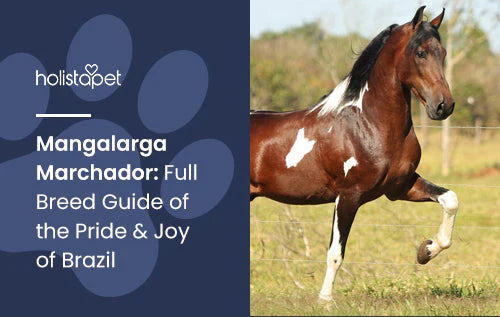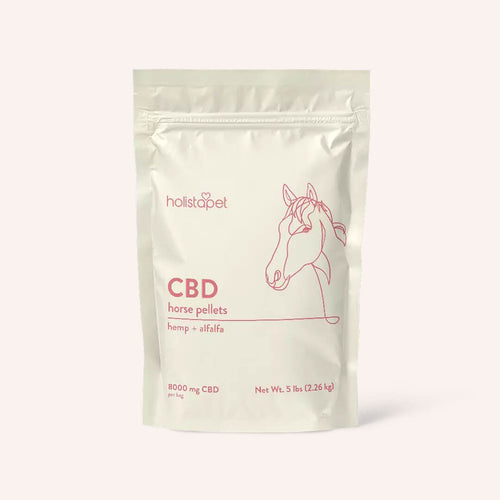The Mangalarga Marchador is a horse with many accolades. They're the national horse of Brazil and prized for their smooth and comfortable "marcha" gaits - which are unique to the breed. In 1994, the breed cemented its place in history and holds the Guinness Book of World Records for the longest endurance ride of 8,694 miles!
Mangalarga Marchadors are extremely versatile as they can work with cattle, perform well in sports, cross-country horsemanship, and on trails. They're also known for their friendly and docile nature and even work well with children. Keep reading to learn more about this unique and dignified horse!
Mangalarga Marchador Horse Characteristics
Mangalarga Marchadors are native to Brazil and one of the most beloved horse breeds in the country. There are over half a million of them in the country alone! In comparison, there are only around 250 registered horses in the US - making them a very rare breed.
Marchadors are a medium-sized breed with a deep chest and long back. They also have muscular hind legs, sloping croup, and hard hooves that makes them perfect for trails.
Their head is triangular-shaped with large nostrils and inward-facing ears. Marchadors also have large, beautiful eyes. The stallions are also known for having a crest in their neck.
Mangalarga Marchador Horse Size
Mangalarga Marchador stallions typically grow to a range of 147 centimeters (14.2 hands) to 157 centimeters (15.2 hands) tall. The ideal height for the breed is around 152 centimeters (15 hands).
The mares are just a little smaller and grow to a range of 140 centimeters (13.3 hands) to 154 centimeters (15.1 hands) tall. The ideal height for mares is 146 centimeters (14.1 hands).
Mangalarga Marchador Gait
Their gait is what really sets the Mangalarga Marchador apart! It's what they're best known for, other than the World Record, of course. They have a gait reminiscent of the famous Spanish Jennets, which have since died out, likely making the Mangalarga Marchador their closest surviving ancestor.
They have four gaits, two of which are completely unique to the breed. In addition to the regular walk and canter (gallop), they have:
- Marcha Batida: An ambling, four-beat diagonal gait similar to a foxtrot. Batida means "to hit."
- Marcha Picada: An ambling, four-beat lateral, rhythmic gait known for its smoothness. Picada means "light touch."
Both marching gaits are faster than a walk and slower than a canter. The smooth gaits are renowned for their comfort because they feature triple support - when three hooves are on the ground simultaneously. These gaits can also immediately switch to a canter without the need to trot or pace for an easy and comfortable ride.
Mangalarga Marchador Horse Personality
Mangalarga Marchador horses are typically very docile and have a gentle temperament. Although they are strong, record-breaking horses, they're also friendly, obedient, and willing to perform. Additionally, they're known for being good family horses! Marchadors are often the first horses that children ride in Brazil.

Mangalarga Marchador History
The Mangalarga Marchador has a storied history dating back to 1700s Spain. Gabriel Francisco Junqueira, the Baron of Alfenas, was the first to develop the breed. It all started with a Lusitano Alter Real stallion named Sublime.
Junqueira received Sublime from his friend Dom Pedro I, the emperor of Brazil at the time. Sublime was raised from the breeding farm Coudelaria Alter do Chao in Portugal. In Brazil, at the Junqueira family estate Campo Alegre, they bred Sublime with the local mares, which were mostly Spanish Jennets and Andalusians.
The offspring were hardy horses with smooth, ambling gaits, reminiscent of their Spanish Jennet ancestor. The family sold some of these offspring to the Mangalarga estate in Rio de Janeiro, which is where the breed took off. The owner of the Mangalarga estate often rode Sublime's offspring to and from Rio de Janeiro, increasing its popularity among local ranchers and earning the name "Mangalarga Marchador," or the Mangalarga Marcher.
Mangalarga Marchador Inspection
Purity and adherence to standards are very important for Mangalarga Marchador horses. In order to be registered, an official breed association must inspect and approve the horse. The United States Mangalarga Marchador Association (USMMA) is the official breed association for all Marchadors in North America.
In the early 1900s, there was some disagreement on what constituted a "pure" Mangalarga Marchador horse. In 1949, a veterinarian and zoologist named Geraldo Carneiro formed the first breed association. The Associacao Brasileira dos Criadores do Cavalo Mangalarga Marchador (ABCCM) was responsible for setting the first breed standard.
The ABCCMM oversees the inspection of Mangalarga Marchador horses for confirmation of breed characteristics, gait, and temperament. Approved horses receive an identifiable horseshoe brand. They are also permanently registered, and approved to breed.
Mangalarga Marchador Naming
Each Marchador horse has a unique first and last name. This surname is a reflection of the breeding farm they come from. It can be placed first, second, or accompanied with a "de," "do," or "da" (meaning "from"). Sometimes it can simply be the initials of the farm. For example, a horse bred in Miami would include "de Miami"; e.g., Chester de Miami.

How to Care for a Mangalarga Marchador
Like all things related to horse care, Marchadors need regular exercise, a healthy diet, routine grooming, and check-ups.
Physical activity is very important for Mangalarga Marchadors. The breed is naturally strong and hardy because they were originally cattle horses. Given their strong work ethic and smooth gait, they excel on endurance rides, so it's a good idea to take them on long trail rides often.
Mangalarga Marchador Horse Training
Mangalarga Marchadors respond very well to training because of their intelligence. As a result, they are incredibly versatile and often achieve excellent results in competitions.
Although they are naturally inclined to work with cattle, you can train them to perform in many sports and activities like:
- Endurance riding
- Trail riding
- Jumping
- Polo
- Brazilian functional trials
- Cross-country horsemanship
Trainers should attempt to perfect the two unique marching gaits for any aspiring competing horse. Once you have properly trained your Mangalarga Marchador, they should be able to seamlessly go from a walk to a marching gait (either the marcha picada or marcha batida) to a canter.
Nutrition and Feeding for a Mangalarga Marchador Horse
Nutrition and diet is the key to a healthy horse. According to the American Association of Equine Practitioners (AAEP), the best and most natural nutrition is long-stem forage, such as fresh grass. If the grass is not available, you should place hay in front of the horse to mimic natural grazing. Generally, horses should consume at least 1% of their body weight each day in forage.
Forage alone is an incomplete diet, and horses should also receive vitamin and mineral supplements and fortified grains. Make sure to talk to an equine veterinarian to meet your horse's specific nutrition needs!
Related: What Do Horses Eat? Top Feeding Guide for Healthy Horses
Coat Color And Grooming
Marchadors come in most solid colors, but the most prominent are:
- Gray
- Bay
- Chestnut
- Pinto
However, breed association does not accept all colors or mixed colors. For example, appaloosa and albino Marchador horses are automatically disqualified.
Marchadors have a beautiful silky coat that requires standard grooming. Remember to brush them daily to remove matting, dirt, and debris buildup. Since they have longer manes and tails, you should brush and wash them often, preferably with detangling shampoo.
You should try to clean out horse hooves before long rides. Ideally, you are cleaning your horse's hooves out daily after their exercise sessions and running around. Dirt buildup can lead to hoof infections if you don't clean them consistently.
Mangalarga Marchador Health Problems
A Marchador's health can suffer if they're on an improper diet or not getting enough exercise. As a general rule of thumb, controlling intake and diet is imperative for good horse health.
Some common health problems a Marchador can have include:
- Equine Metabolic Syndrome (EMS): EMS is common in overweight horses. Some common symptoms are obesity, laminitis, insulin resistance, infertility, and increased appetite. The good news is that treatment is pretty simple: changes in diet and more exercise.
- Polysaccharide Storage Myopathy (PSSM): PSSM results from too much sugar in the horse's body. Some of the symptoms include muscle stiffness, sweating, and slow movement. You can help fight PSSM in your horse by reducing their sugar intake and maintaining a healthy weight.

How to Get a Mangalarga Marchador
Unless you have a connection to a Brazilian farm, the rarity of Marchadors makes it difficult to find. However, with some patience and dedication, you can track down online on websites like eHorses and EquineNow. These are international horse marketplaces where breeders post horses for sale. You can find everything from frozen semen to mares and stallions. Mangalarga Marchadors averages around $1000 for frozen semen, $6000 for a foal, and up to $17,000 for a mare.
More About This Horse Breed
The Mangalarga Marchador almost seems like a horse of legend. It has a lineage directly linked to Brazilian royalty. The breed has a proud bloodline that maintains standards of purity, a one-of-a-kind gait, record-breaking endurance, and almost endless versatility. You can sum up Marchadors in the motto of the Brazilian breeders association: they're a breed without frontiers.


 CBD Oil for Horses - Fast Acting
CBD Oil for Horses - Fast Acting
 CBD Pellets for Horses - Easy Dose
CBD Pellets for Horses - Easy Dose
 "Ridin' On My Horse" Bundle - Highly Rated
"Ridin' On My Horse" Bundle - Highly Rated





Leave a comment
All comments are moderated before being published.
This site is protected by hCaptcha and the hCaptcha Privacy Policy and Terms of Service apply.